A step by step guide on how to grow sweet potatoes & how to start slips. Growing sweet potatoes used to be a closely guarded secret among farmers. A mystical, mysterious process - like how to perfectly apply liquid eyeliner. Not anymore!
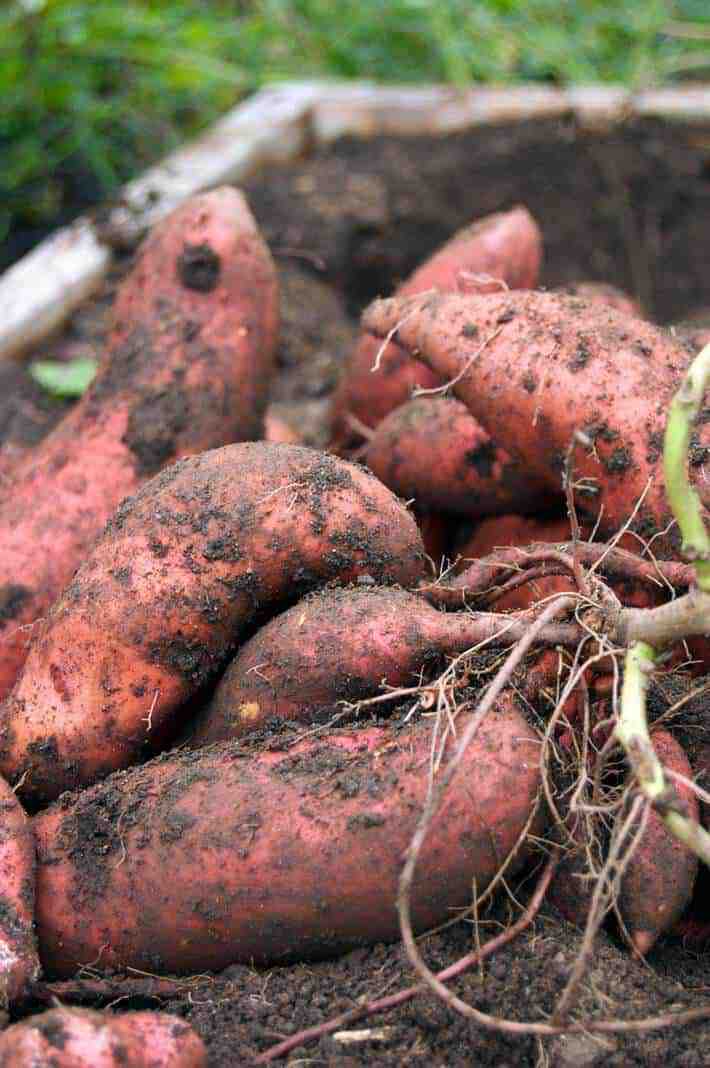
I've successfully taught thousands of you how to grow luffa in a cold climate (zone 6) and sweet potatoes (known as Kūmara where it's hugely popular in New Zealand) are no different.
It can be done and you can get a HUGE harvest even in a short season - you just need to follow the steps.
In 2010, when I first started growing sweet potatoes (Ipomoea batatas), there was almost no information on the Internet about it. At that time, growing sweet potato slips was a closely guarded secret in the farming community.
Not anymore.
Table of Contents
Two ways to grow sweet potato plants
🌱 It starts with growing the slips. 🌱
In order to grow sweet potatoes, you have to first grow sweet potato slips. These are the sprouts that come off of the sweet potato.
Every slip will grow into a sweet potato plant that will produce around 2 pounds of sweet potatoes
1. IN WATER
2. IN SOIL

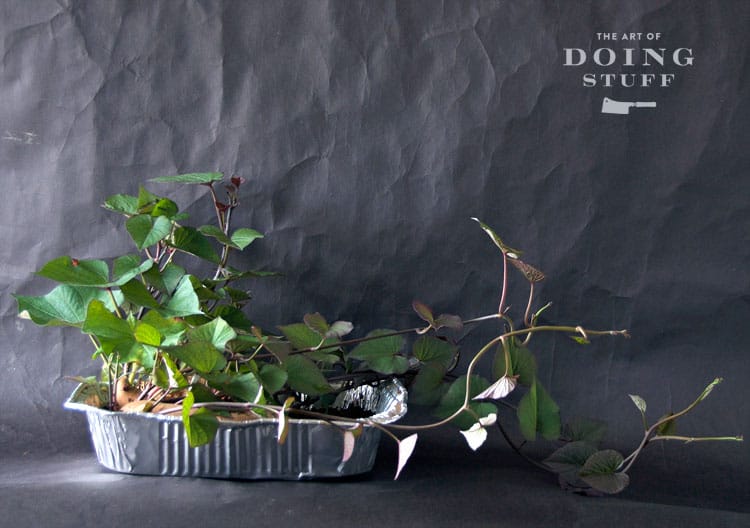
Sweet potatoes sprout after they break dormancy just like the perennial plants in your garden do. These sprouts are called slips and they're what you use to grow sweet potato plants.
You can encourage your sweet potato to break dormancy by putting it in a warm room in either a glass of water or some soil.
Water Method
With this method you're generally safe to start your slips 6 weeks prior to when you want to plant them out.
STEP 1. Place sweet potatoes in a glass jar of water with half the sweet potato under water and the rest not. The part under water will grow roots and the part above water will grow slips.
STEP 2. Put the jar somewhere WARM - over 80℉ is ideal. Now you wait about a month for it to root and sprout.
STEP 3. Once the slips are a few inches long they can be pinched off of the sweet potato and rooted in water or planted in 4" pots.
STEP 4. Slips can be planted outside once the soil temperature is 65ºF (or 18ºC).
Soil Method
The soil method produces slips more quickly. With this method you're generally safe to start your slips 4 weeks prior to when you want to plant them out.
STEP 1. Place whole sweet potato(es) lengthwise in a pan of soil so the soil comes halfway up the side of potato.
STEP 2. Place the pan on a seedling heating mat.
STEP 3. Make sure the soil stays moist and wait for it to produce roots / slips in 2 weeks or less.
STEP 4. Once the slips are a few inches long and you can either put them in a glass of water to root, or plant them directly in soil to root. Either way is fine. Rooting in a glass jar takes up a lot less space than putting each slip in a 4" pot with soil.
STEP 5. Slips can be planted outside once the soil temperature is 65ºF (or 18ºC).
TIP! It's the warmth of the heat pad that speeds up the sprouting process.

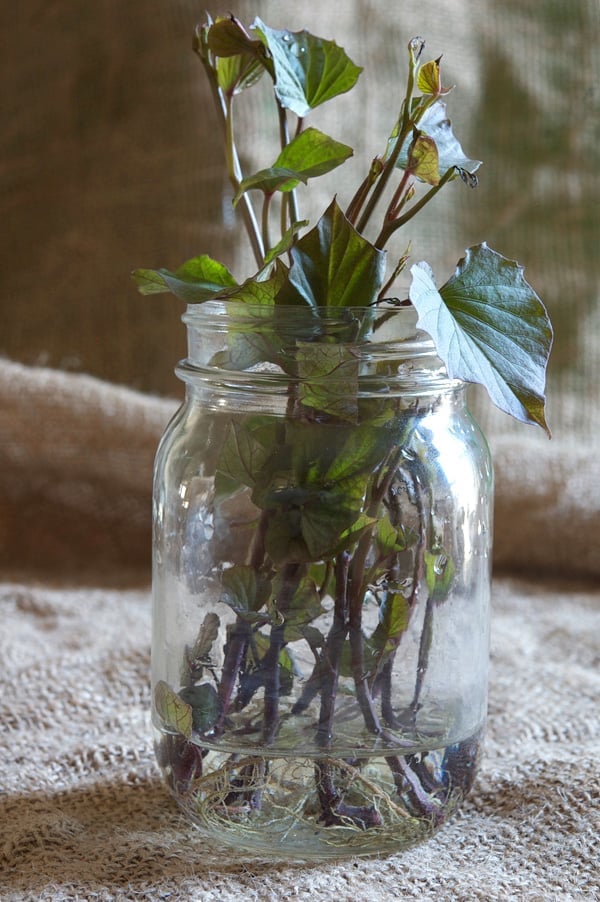
How to plant
Sweet potatoes will be one of the last things you plant in your garden. They must go in later than peppers, tomatoes and other heat loving plants because sweet potatoes need more than just warm weather. They need warm soil as well as warm air.
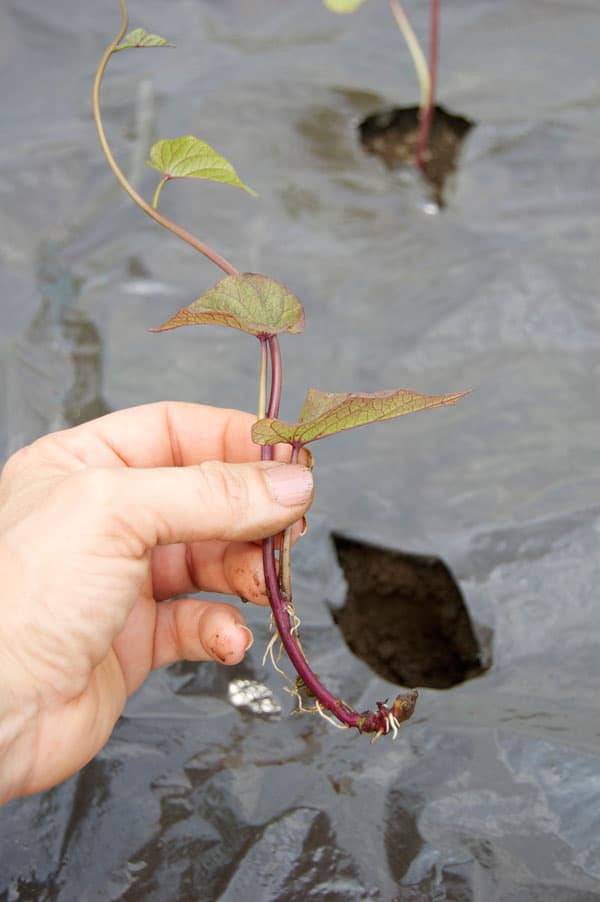

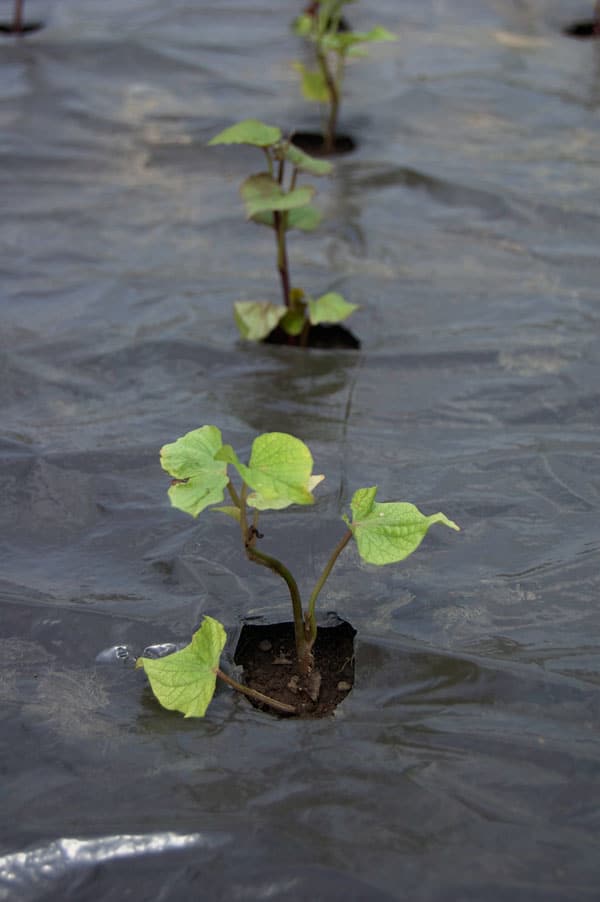
STEP 1. Apply a couple of inches of compost to the top of your soil. You can also use a slow release fertilizer; I use Gaia Green's 4-4-4 fertilizer in my garden.
STEP 2. Lay black thermal mulch (plastic) on the planting area 2 weeks before setting out. Sweet potatoes need full sun so make sure your area has that.
STEP 3. On planting day cut a circle in the plastic and push one slip in. Make sure the slip has contact with soil all around. Repeat for all your slips.
STEP 4. Proper spacing for planting is 1 sweet potato slip per square foot. HOWEVER, I find spacing of 16" between sweet potato plants increases your yield & the size of your sweet potatoes.
STEP 5. Keep the plants well watered throughout the summer. Using the plastic eliminates the need to weed and helps retain moisture.
STEP 6. Harvest before the first frost. Once the weather cools down they won’t grow anyway.
* Speed up your soil warming by laying a layer of black thermal plastic in your garden bed. I use biodegradable plastic made of cornstarch that just decomposes on the soil by the end of the season. It will heat the soil up by as much as 10 degrees which means you can plant the slips 1-2 weeks sooner than if you don't use thermal plastic.
.
Growing in beds
Growing in containers
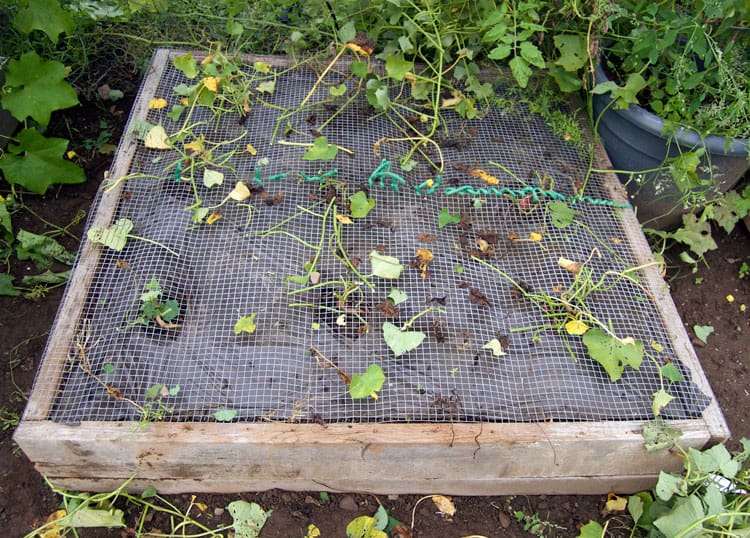

If you grow sweet potatoes in the ground you may find voles & mice get to them before you do. Hardware cloth can help with this. If you can't find it locally, Amazon carries hardware cloth.
- Cover your sweet potato bed with ¼" hardware cloth. Grow your sweet potatoes in a raised bed with wood sides. After laying your plastic down, staple hardware cloth around the edges of your bed.
- Plant the slips you have to punch a hole into the plastic with a pencil and push the slip through the hardware cloth, plastic and into the soil. THIS IS A PAIN. But it eliminates 100% of rodent damage.
I grow all of my sweet potato plants in containers.
- Plant 1-2 sweet potato slips in a 60 litre pot that measures 60 cm across.
- Remember to keep the pots watered as they'll dry out more quickly than a garden bed.
Once your plants are well established you can also harvest and eat the leaves.
Use them in: salads or cook them like you would spinach or chard.
This video shows my sweet potato harvest in 2016 after I tried using the hardware cloth the first time in a raised bed in my 40' x 40' community garden plot. In this video I'm using regular thermal plastic, not the biodegradable plastic.
How & When to Harvest
Near the end of their growing life sweet potato vines will start to yellow and croak. This is a GOOD sign! They're ready to harvest.
- Cut the tangle of vines away, leaving only a few stubs to let you know where the plants are.
- Using a shovel or digging fork, dig em up! Honestly, the most fun crops to grow are the ones that grow underground because you have NO idea what you have until the day you dig them up.
- Be careful when you're digging them and pulling them out. They bruise and break easily.
- Once they're all dug let them sit in the sun for a few hours to dry and begin the curing process.
If the vines get touched by frost and start to turn black the sweet potatoes can rot quickly so dig them up right away!
How to Cure & Store

Curing
Sweet potatoes need to be cured for 10 days in an area that is 85ºF with 85% humidity. Getting those conditions at home probably seems difficult but just get as close to those ideal conditions as you can.
Why do you have to cure sweet potatoes? Curing toughens the skin so they keep longer and it develops their distinct sweet flavour. A sweet potato dug straight out of the ground won't taste sweet at all! Try it.
Here's how:
- Put your sweet potatoes in a rubber bin with the lid offset so it isn't completely sealed off. Store this near a heat register, wood stove or sunny spot. This will create conditions as close to perfect as you can get in most houses. DO THIS FOR 10 DAYS.
- After the initial 10 day curing period move your sweet potatoes to an area that is between 55-60ºF for one month. This develops their flavour. After 1 month they will have developed their sweet potato flavour which will get even stronger as time goes by.
Storing
Store sweet potatoes in an area that doesn't get below 50 degrees in a container that breathes like a slatted wood box or a burlap sack.
How many sweet potatoes do you get per plant?
2 lbs or 4 sweet potatoes per sweet potato plant.
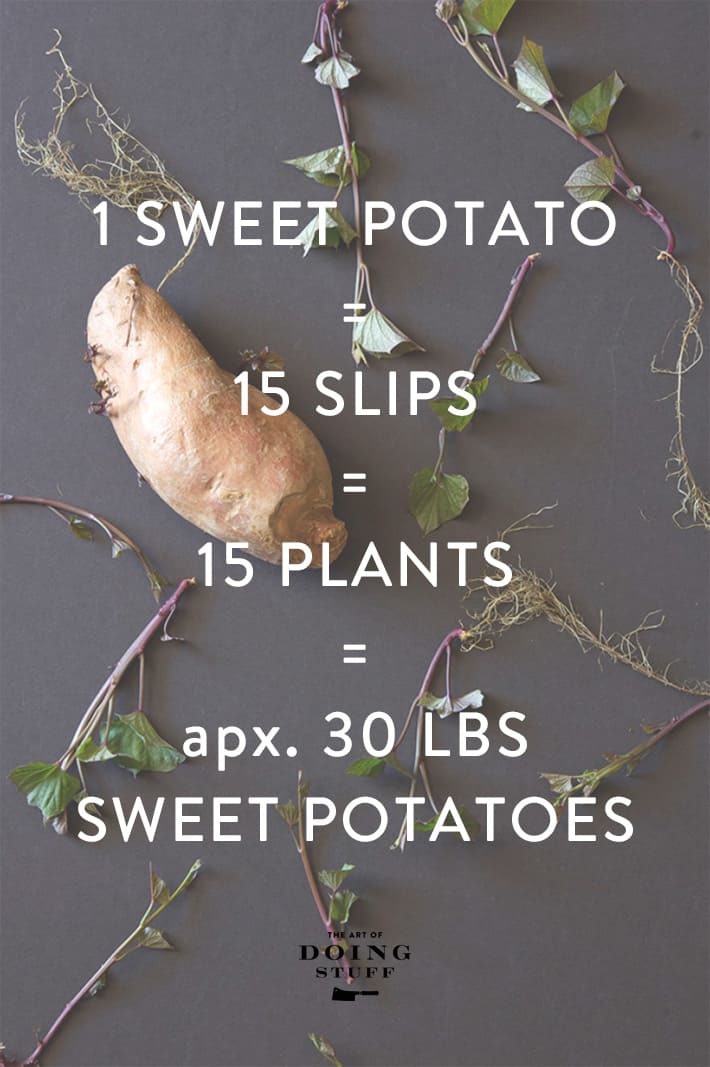
1 sweet potato plant will produce about 4 large sweet potatoes, or 2 lbs of sweet potatoes. Some varieties will produce 6 or more per plant.
The plant usually creates 1 very large sweet potato, along with a few smaller ones.
A single sprouting sweet potato can provide you with at least 15 slips (that's a low estimate). Those 15 slips will create 15 plants, which will give you around 30 lbs or 60 individual sweet potatoes.
Where to buy slips
If you don't want to grow your own you can buy potted sweet potato plants at many garden centres now and you can order live slips online.
Growing from store bought sweet potatoes
To grow your own slips all you need is a sweet potato that hasn’t been treated to stop sprouting which you can get at the grocery store.
How do you know if it’s been treated? You don’t. You go to the store, buy your sweet potato and hope for the best. Organic is your best bet for an untreated sweet potato, but both organic and "regular" store bought sweet potatoes have produced slips for me.
Tips on picking a sweet potato from the store to grow
- Check for cold damage. If the sweet potato has been exposed to below 55 degree temperatures it will probably rot rather than sprout. Cold damage presents with dark marks and lesions.
- Bigger isn't necessarily better. Small sweet potatoes, in my experience, have produced more slips than larger ones.
- Ask if they were grown locally. Locally grown means it will grow well in your region.
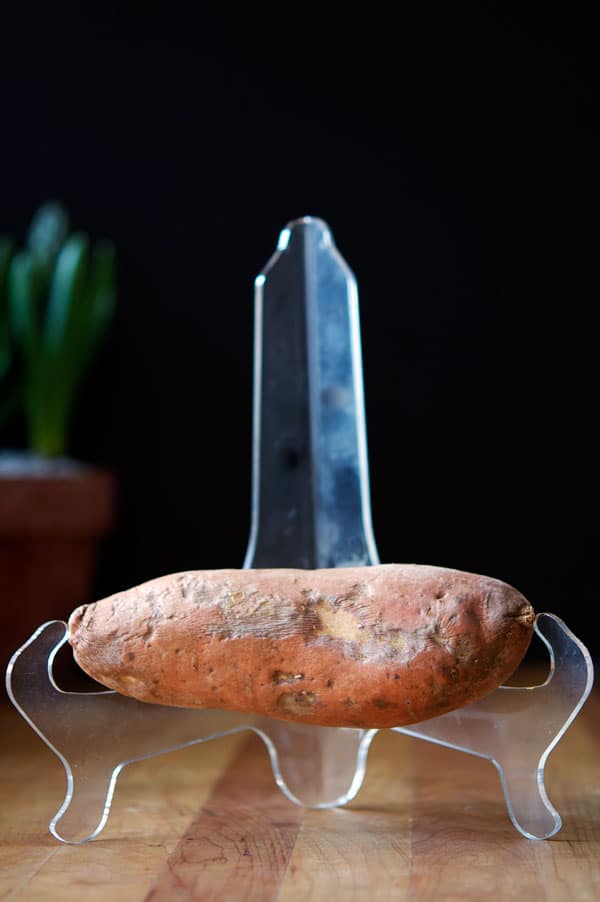
Sweet Potato with cold damage
Once you've established your very OWN crop of sweet potatoes you can use those for producing slips year after year.
Are ornamental sweet potatoes edible?
You may have noticed that your ornamental sweet potatoes also produce tubers. These tubers are edible but not delicious.
The good news is you can propagate ornamental sweet potato vine the same way as regular sweet potatoes! Just dig up the decorative sweet potato tuber in the fall, store it in a cool room, and then encourage it to grow slips in the spring. These slips can be planted directly outside or rooted and potted up for later planting.
Varieties of Sweet Potatoes
The most popular sweet potato variety by far is Beauregard and it'll be the easiest for you to find. But there are a lot more varieties than that.
- Beauregard* (best all around sweet potato variety)
- Georgia Jet (short season variety)
- Jewel (longer season but still doable in colder climates)
- Garnet (a purple variety with purple skin and flesh)
- Stokes (bright purple variety that retains its colour after cooking)
- Covington (a standard variety that grows well in cooler cliimates)
*this is the sweet potato I most often grow.
Note: I have successfully grown all of the above (with the exception of "Stokes") in my Canadian garden. I just haven't tried Stokes, but I'm sure it would be fine.
Sweet Potato VS Regular Potato


To clear up any confusion, sweet potatoes don't grow like regular potatoes. A regular potato is a tuber, a sweet potato is a root.
Regular potatoes are grown by planting whole "seed" potatoes into the ground. (here's my guide on how to grow regular potatoes)
Sweet potatoes are grown by planting only the sprouts aka slips that grow from the sweet potato.

The Start to Finish Guide to Growing Sweet Potatoes.
How to successfully grow sweet potatoes whether your garden is big or small.
Materials
- Glass of water
- Foil pan with soil
- A sweet potato
Tools
- Heat mat
Instructions
- Start sweet potato slips 6 weeks prior to planting out.
- Rest a whole, undamaged sweet potato in soil and set on a heating mat. Slips will start to grow in around 2 weeks. When around 5", break slips off of sweet potato and plant out or root in water.
- Rooted AND unrooted slips can be planted directly in the soil.
- Speed up how quickly you can plant your slips outside by laying down thermal plastic
- To prevent vole/mole/mouse damage either grow sweet potatoes in very large pots or grow in a raised bed with wood sides and ¼" hardware cloth across the top.
- Dig up sweet potatoes when the weather cools in fall.
- Cure sweet potatoes at 85F and 85% humidity for 10 days.
- Cure another month at 55-60F allowing potatoes to develop sugars.
- Store long term in vented crates or burlap bags at no colder than 50F
Sweet potatoes can be harvested 4 to 5 months after planting.
You get around 4 sweet potatoes per plant. Usually one very large one and a few smaller but still substantial ones. Some varieties under the best conditions will produce even more.
Any potting soil will work well. It has the nutrients you need. If you are reusing potting soil you'll need to amend by adding fertilizer. Adding a 4-4-4 fertilizer or a few inches of compost to the top of the depleted potting soil will revive the soil. I also use native garden soil in my sweet potato containers.
Yes, that's exactly how you grow them but you don't plant the entire sweet potato. You let the sweet potato sprout in a warm place, pull the sprouts off when they're a few inches long and then root or plant those in soil.
May or June are the best months to plant sweet potatoes outside when the soil at planting depth has warmed up to 65ºF (or 18ºC).
Yes! Sweet potatoes do really well in beds, buckets or pots. Buckets and pots are especially good for growing sweet potatoes because they keep the soil warm and prevent moles and mice from eating the growing tubers.
Once you have a whack of sweet potatoes that you've grown yourself, if stored in good conditions, they'll last you into April or even May.
You can turn them into my personal favourite guaranteed crispy Sweet Potato fries with a Sriracha/mayo dip, Sweet Potato soup or sweet potato casserole.
Now go forth and grow.
→Follow me on Instagram where I often make a fool of myself←




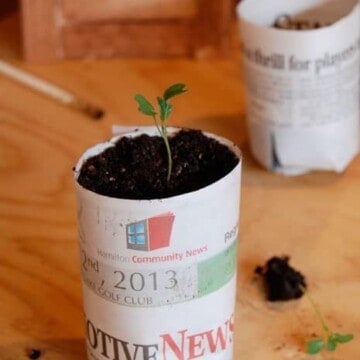

My sweet potato started sprouting slips just sitting on the Kitchen counter, but now what stopped growing for the last 2 weeks. I live in the tropics (Zone 11b) and It’s about 80-85 degrees in the house. Why did it stop? The last time at this point, I buried it halfway in moist soil and it molded. Please advise!
Hi Tiare. If they're just sitting on the counter it's possible they stopped growing because they're drying out. Put them in water or soil like you say. If you got mould you either need more air circulation (set a fan in front of the plant) or the sweet potato was just at the end of its life cycle because of stress and it rotted. Try again. :) ~ karen!
Hi, I'm in Zone 5b. It is mid-Sept and my sweet potato plants were flourishing - filling a large bed in a fenced in garden, lots of flowers . ..then the deer jumped the fence and wires - decimated the leaves, flowers and I just see the ropy stems .. Is everything lost, will I get any harvest?
Hi Maureen! It depends on when you planted them. But if you had flowers chances are the sweet potatoes underneath have already had a chance to grow so I'd think that yes, you'll have some sweet potatoes. If there are no leaves left on your plants then you can dig them up right now to see because without leaves they won't grow anymore this year. ~ karen!
Yes, NC is the sweet potato capital of the western hemisphere. We grow 60% of the total US production, thats 50% more than the other 49 states combined. There are multiple potato warehouses in my region, one of them can store 2 million bushels of sweet potatoes. You can even pick your variety, if you know what you like. I like Murasaki and Bonita (both are white sweet potatoes). Covington is one of the more popular orange potatoes.
Do you think that sweet potato could grow under my corn in the corn patch?
Hi Karen, Ur website has great info on growing sweet potatoes; I'm trying it for the 1st time. I googled & tried growing them in water for weeks & the sweet potato just rotted! I couldn't figure out why until I read Ur info; it obviously was sprayed as U stated! I then cut off sprouts from a sweet potato & buried them in peat moss & perlite according to one website, & it worked!! I'm planting the slips in a container. I have couple of questions:
Do I move the pot to full sun once the slips are established in the pot?
I covered the pot with wood mulch to prevent the pot from drying out; is this good or bad?
And what fertilizer to use?
Thank U.
Corinne
Hi Corinne. I'd like to know how large your container is. You need a very large container for even just 1-2 sweet potatoes. It's how I grow them now, and it works great, but you have to be careful not to overcrowd them. The slips should only need a few days to harden off (get used to the strong sun and winds). Just do it gradually letting them get more and more sun every day. The wood mulch should be fine, but you're better to cover them with some sort of black plastic to help with heat retention. I don't use fertilizer, I just put 2" of compost on top of the soil before planting. Hope that helps. ~ karen!
Because in years past the sweet potato vines have almost overtaken the garden can they be trimmed back to prevent this happening
Hi Trudy. I don't cut mine back I just twirl them in on themselves so they aren't splayed all over. You can use garden staples to hold them in place if you need to. ~ karen!
Hi Karen, great article, so informative and has really helped me to the stage where I have my slips growing nicely in pots, waiting to be planted out. I have a question though! They have a kind of crystal, white substance on the top of the leaves, definitely not a pest but I’m not sure what it is, or if it could be a problem. I think my variety are tainung. Any ideas?
Hmm. I actually have no idea what that might be Alex, lol. If they rub off they could be a pest like mealybugs. In which case it's easiest to just hand remove them for now while the plants are small. If they stick and seem to be part of the leaf ... well then I'm not sure what they would be! ~ karen
How much sun and/or shade is ideal? I live in Western NC where lots of sweet potatoes are grown, but this will be my first time trying.
Also, we also have lots of voles in our yard...it looked in the pick like you put the mesh on top of the raised bed, is that the top or the bottom in the pic?
Hi Valerie! I put the mesh across the top of the bed. The voles don't bother with tunnelling under the raised bed. You can also grow them in large pots which is what I do the odd time and they grow great. But just one sweet potato per HUGE (50L) pot or they'll feel crowded. I'm not sure about the amount of sun in NC because in zone 6 where I am, they do best with the most amount of light possible. 8 hours at least, but if NC where the sun is possibly hotter you might get away with 6 hrs. ~ karen!
Thank you for the fun and wonderful article! I haven't mastered this yet, but I WILL WIN. And because I'm a horrible person I'm going to mention a video I once watched where the gardener demonstrated how to grow "thweet pothatho slipths". It'll bring you to tears.
Karen, I found your site the most helpful on growing slips! Please give your two cents on this issue... I was trying to post this after a post someone left about sweet potatoes being toxic to dogs, but the site was derping out. Sweet potatoes cultivated for food and their Vines are NOT toxic to dogs, cats, or horses per the ASPCA website... they are listed as non toxic for all three of those Critters. The internet has information all over the map, so it would be wise to check on the particular variety you are growing, but I think the toxicity issue is mostly related to ornamentals, not those cultivated for food. Do you find this to be true in your research Karen?
Hi, I became bored during lockdown started trying to grow leeks and lettuce from their bottom bit, you cut off and I read a load of things and Sweet potatoes were in there too. So I cut a large piece off the end of a Sp and stuck it in a jar of water. I have 2 slips and the cut end of the potato has roots. What or how should I proceed. Can I cut it in 2 and plant each slip like that or do I have to take the slip off the potato? Thank you hoping to get an answer.
Hi Dawn. You take the slip off the potato. Just break it off. It'll pull right off of the potato. And then ANOTHER slip will grow. So once your slips reach 3-4 inches break them off and stick them in a cup with a bit of water. While they're rooting, the potato will produce more slips. Good luck. ~ karen!
Very informative, and I now have two potatoes sprouting. But one question. When I break off the slips, are they supposed to have roots on them?
Hi Marti. If the slip happens to grow near the base of the potato where it's rooting into the soil it *might* have roots, but that's just an added bonus. The majority of them won't have roots until you either plant them in soil or root them in water. ~ karen!
For your method of growing siplings on the seedling heat pad, do you remove the pans of sweet potatoes that have the holes on the bottom from the pad for watering and then replace back on pad after the drainage or explain how you do it.
This is the BEST site I've looked at for growing sweet potatoes -- or yams or whatever you want to call the orange kind. I did the soil method and kept the container on a hot mat and used small sweet potato from the grocery store -- on the assumption that if it did not work then I had not wasted a larger one. But, it worked! Very well, actually, and now I have many gorgeous slips and I am a happy gardener. I'm now pulling the larger slips off the tuber and am soaking them in water to get more roots while still keeping the "mother" sweet potato in the soil and on the mat. I'm going to plant them into two very large 14" high containers. All my raised beds are spoken for already. Happy gardening.
Perfect! It sounds like you're even further along than I am, lol. ~ karen!
II'm trying to use your approach this year. I had a leftover small tray from my old toaster oven, and I've found that 1 pound packaging from strawberries perfectly holds a nice sized sweet potato and some dirt, and already has plenty of drainage holes.
Still waiting on a heat mat, so I've got it over the heater vent for now, and monitoring the dampness of the soil.
I've also got some leftover pond liner that I'm planning to use to put over the beds where they will go - I figure if 1/8" black plastic won't stop the weeds and absorb heat, nothing will.
Yes, the pond liner is perfect! Good luck with your sweet potatoes! (I hope you've started them early enough, if you can notice any sprout tips at all then you'll be O.K.) ~ karen!
This is by far easiest method I’ve found. Plant is healthier. Heaps slips. Thank you!!!
And I didn’t bother with a heat mat. I had an old wok and figured that would do lol
How often to water the soil once the slips are planted?
Hi Karen, I'm dropping this question in your "comments" section. I know i'm in the wrong category, but i'm old and have no memory and have spent a long time searching on your site and on old emails.
I'm trying to find your reco of a kind of (?) flower - is it a marigold - that you're growing for the licorice foliage, not the flower. I'm looking for variety and of course, if i've gotten the flower incorrect.
thanks for direction you can give.
Also - do you have an experience ordering from Fedco in Maine? It's a gardening coop. Just interested in your experience if you have.
thanks -kunyi
Hi Kunyi! The marigold is called Dropshot. :) ~ karen!
Thank you. I ordeeed some seeds but they're way behind and might take them quite a while to get here. Next year maybe.
Forgive me ahead of time if I'm not grasping this. I understand it's different than tuber potatoes and I think this question was sort of asked above. If I have a portion of a potato (an end with a slip started) could I try putting that into warm, moist soil or would I be inviting infection? Just not sure if it's always a complete potato that needs to be started.
Hi! I was afraid I am too late to start sweet potatoes but I googled the fastest way and here your blog is! I already followed you on Insta. I hope it will be fast because I'd like to plant in a month. Here in Houston area so it will be definitely hot enough.. We shall see.
Question - is it ok to plant them where we had our white potatoes? Or are there pest/nutrient reasons not to? Those will be harvested by the time the sweets are ready.